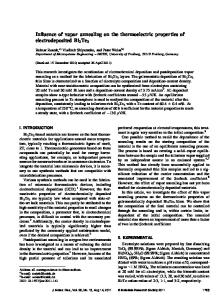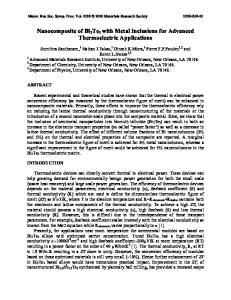Substitutions in the Homologous Family CsPb m Bi 3 Te 5+m and Preliminary Thermoelectric Results
- PDF / 192,410 Bytes
- 6 Pages / 612 x 792 pts (letter) Page_size
- 109 Downloads / 369 Views
0886-F08-06.1
Substitutions in the Homologous Family CsPbmBi3Te5+m and Preliminary Thermoelectric Results Aurélie Guéguen, Eric Quarez and Mercouri G. Kanatzidis Department of Chemistry, Michigan State University, East Lansing MI 48824, USA ABSTRACT We report analogs of the homologous family CsPbmBi3Te5+m, namely Cs0.74K0.76Bi3.5Te6 (1), CsNa0.98Bi4.01Te7 (2), Cs0.69Ca0.65Bi3.34Te6 (3), Rb0.82Pb0.82Bi3.18Te6 (4), Rb0.19K1.31Bi3.50Te6 (5), RbSnBi3Te6 (6), Rb0.94Ca0.94Bi3.06Te6 (7) and RbYbBi3Te6 (8). They all crystallize in the orthorhombic space group Cmcm and are isostructural to CsPbBi3Te6 the first member of the family except for CsNa0.98Bi4.01Te7 which is isostructural to CsPb2Bi3Te7, the second member of the family. The R1 factor was 0.0455 for (1), 0.0491 for (2), 0.0367 for (3), 0.0287 for (4), 0.0458 for (5), 0.0498 or (6), 0.0560 for (7) and 0.0356 for (8). Preliminary thermoelectric measurements on Cs0.76K0.74Bi3.5Te6 show electrical conductivity values in the range of 600-1000 S/cm. The thermopower shows n-type charge transport with room temperature values of ~ -35 µV/K. By comparison, the electrical conductivity at room temperature of Rb0.82Pb0.82Bi3.18Te6 was ~1400 S/cm, while the thermopower was ~ -20 µV/K. INTRODUCTION The discovery of new thermoelectric materials with superior properties is one of the main challenges in solid state chemistry and physics. One promising candidate for cooling applications is CsBi4Te61. Recently, our efforts to produce new materials that resemble CsBi4Te6 led to the discovery of the homologous series of materials CsPbmBi3Te5+m2, 3, 4. The four members of the series (m=1, 2, 3 and 4) were obtained by introducing various equivalents of PbTe into the layered framework of CsBi4Te6. The CsPbmBi3Te5+m compounds show low thermal conductivity compared to that of Bi2Te3 and CsBi4Te6. Preparing analogs of such compounds can be a way to tune the thermoelectric properties. First, we attempted substitutions of the Pb atoms with different elements such as Ag, K, Na, Ba, Sr, Ca and Yb. Then, both Cs and Pb were replaced, Cs by Rb and Pb with the elements above. We were able to synthesize eight new compounds: Cs0.74K0.76Bi3.5Te6, CsNa0.98Bi4.01Te7, Cs0.69Ca0.65Bi3.34Te6, Rb0.82Pb0.82Bi3.18Te6, Rb0.19K1.31Bi3.50Te6, RbSnBi3Te6, Rb0.94Ca0.94Bi3.06Te6 and RbYbBi3Te6. Single crystal diffraction studies indicated that all compounds are isostructural to CsPbBi3Te6 the first member of the family except (2) which is isostructural to CsPb2Bi3Te7, the second member of the family. Here we present a summary of single crystal refinement data and discuss the preferential substitutions between cations in various metal positions. Preliminary electrical conductivity and thermopower data for (1) and (4) are also reported. EXPERIMENTAL SECTION The compounds were prepared by loading the elements in appropriate stoichiometries into silica tubes under a dry nitrogen atmosphere in a Vacuum Atmosphere Dry-Lab glove-box. In the case of compounds with calcium, CaTe was used as a starting material. The tubes wer
Data Loading...











